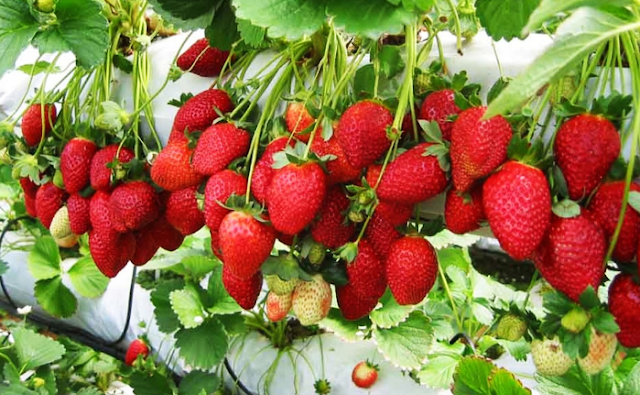How to grow Strawberry
Production Technology of Strawberry
Botanical Name: Fragaria vesca
Family: Rosaceac.
Importance
• Maintain eye health.
• Maintain a healthy digestive system.
• Anti-inflammatory and Cancer.
• Keeping the immune system.
• Maintain heart and bone health.
• Keeping brain function.
Climate
Strawberry grown best in temperate climate. It is a short day plant, which requires exposure to about 10 days of less than 8 hours sunshine for initiation of flowering.
Soil
Strawberry requires a well-drained medium loam soil, rich in organic matter. The soil should be slightly acidic with pH from 5.7 to 6.5. At higher pH (acidic) root formation is very poor. The presence of high calcium in the soil causes yellowing of the leaves. In light soils and in those rich in organic matter, runner formation is better.
Varieties
BARI Strawberry 1, Rabi I, Rabi 2, Rabi 3, Modern Strawberry 1, Modem Strawberry 2, Modern Strawberry 3, Modern Strawberry 4, Modem Strawberry 5.
Land Preparation
The soil is ploughed during summer with a soil turning plough which is followed by repeated ploughing to make soil friable, remove weeds and stubbles. Soil fumigation with a mixture of methyl bromide and chlropicrin helps to increase root system, reduce fertilizer requirement and control the 1 weeds.
Planting
Planting Material: Strawberry is commercially propagated by runner plants. For large scale propagation of virus free plants, tissue culture is widely used.
Planting time: Mid-September to Mid-October.
Spacing: The usual practice is to plant on raised beds 4 x 3 meters or 4 x 4 meters.
In strawberry farming, planting distance varies according to variety & type of land. A spacing of 30 cm X 60 cm is usually followed. In the model scheme, a spacing of 30 cm X 30 cm with a population of 22,000 plants per acre has been considered which was commonly observed in areas covered during a field study from row to row.
Fertilizer Application
· FYM: 25-50 ton/ ha.
· N: 75-100 kg/ ha.
· P205: 40-120 kg/ ha.
· K2O: 40-80 kg/ ha.
Total P205, FYM and 1/2 K2O applied during final land preparation. Rest K2O and Urea applied 4-5 times at 15-20 slays interval followed by 15 Days after planting.
Intercultural operation
Plants care: The roots of strawberry plants spread out close to the surface. Therefore, the soil should be well supplied with moisture, and hoeing should be done lightly and young plantation be kept weed free
Horticultural practices: In cold climatic conditions the soil is covered with a mulch in winter to protect the roots from cold injury. The mulch keeps the fruits free from soil, reduces decay of fruits, conserves soil moisture, lower-s soil temperature in hot weather, protects flowers from frost in mild climates and protects plants from freezing injury in cold climates. Several kinds of mulches are used, but the commonest one is straw mulch. The name strawberry has been derived from this fact. Black alkathine mulch is also used to cover the soil. It saves irrigation water, prevents the growth of weeds and keep the soil temperature high.
Weeding: The field is kept weed free during the first season by harrowing & ploughing, applying herbicides or plastic sheet. Inter-cultural practices are continued till the straw mulch is applied.
Irrigation:Strawberry being a shallow-rooted plant requires more frequent but less amount of water in each irrigation. Excessive irrigation results in growth of leaves and stolons at the expense of fruits & flowers and also increases the incidence of Botrytis rot. Irrigation is applied in furrows between the rows. Trickle and sprinkler irrigation systems are becoming popular nowadays. In case of trickle irrigation, 30% water and energy are saved.
Training: Four different types of training systems viz. matted row, spaced row, hill and plastic mulch are used to train the strawberry plants.
Insect pest
White grubs, cutworms and hairy caterpillars attack the crop.
· Areas where strawberries are to be planted should be free from white grubs and cutworms.
· Application of endosulfan (0.05%) or Malathion (0.05%) on appearance of caterpillars has been found to be effective in most cases.
Diseases
Main diseases reported are leaf spot and grey mould. Strawberry also suffers from virus diseases known as yellow edge, crinkle and dwarf
· Application of Carbendazim thiophanate methyl has been found to be effective in most cases.
Disorders
Albinism (lack of fruit colour during ripening) is a physiological disorder in strawberry. It is probably caused by certain climatic conditions and extremes in nutrition. Fruits remain irregularly pink or even totally white and sometimes swollen. They have acid taste and become less firm. Albino fruits are often damaged during harvesting and are susceptible to Botrytis infection and decay during storage.
Harvesting
· Strawberries are generally harvested when half to three fourths of skin develops colour.
· Depending on the weather conditions, picking is usually done on every second or third day usually in the morning hours. Strawberries are harvested in small trays or baskets. They should be kept in a shady place to avoid damage due to excessive heat in the open field.
· Plants start bearing in second year.
Yield
An average yield of 45-100 q/ha is obtained from a strawberry orchard. However, an average yield of 175-300 q/ha may be taken from a well-managed orchard.
